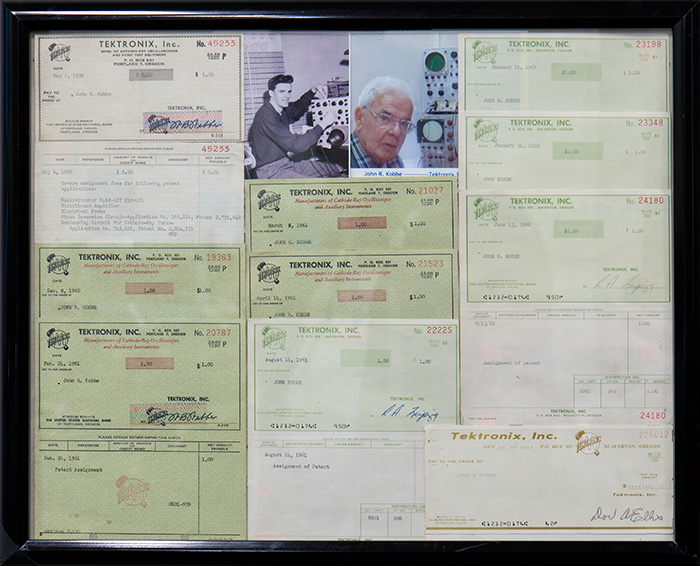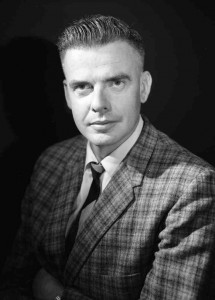At the time I came to Tektronix in 1951, Howard seemed sort of opposed to the patent system. Besides that, they hadn’t the time or the funds to worry about patents. I will throw in a little story I heard about Howard. To set the stage, in the late 1940s, AT&T was part of the Bell Telephone System, who had a monopoly on the telephone system in most of this country. The general public was starting to complain about their monopoly and telephone bills.
When the 511 started to catch on, AT&T contacted Tek demanding a royalty on each scope that Tek sold. Howard answered them saying he would pay the royalty but would invoice the customer with two bills, one for the scope and the other to pay the AT&T royalty. AT&T apparently dropped the idea, as no more was heard from them. To sum up what I think. Howard didn’t much like the idea of the patent system but did believe in protecting against others directly copying a product. The patent seems to be the only way to do it.
About the time of the move to the Sunset plant, Dick Ropiequet and others had come up with a wide range sweep circuit and a better sweep magnifier. I think it was also him that came up with the idea of a bi-stable Schmitt for a trigger circuit, where you could control the voltage level of the trigger. I had come up with an un-blanking idea and a simplified sweep circuit (both originally aimed at the scope class, but ended up being used in the new generation scopes). With all of those things coming together, along with deciding to manufacture our own CRT, we were on our way toward a new generation of oscilloscopes that ended up being called the 531 and 535. This was the time Howard and others decided we should start applying for some patents. Many of the patents were not applied for right away, as we had one year from when the idea is made public (in Tektronix case it was usually when the first instrument was shipped). After the patent was filed, there was usually a lot of back and forth between the patent examiner and the patent lawyer. We were not in any hurry because the longer the delay the more it delayed the patent expiration.
Another interesting bit of patent history (I am unsure of the date but must have been in the late fifties) representatives of HP and Tektronix, maybe only Howard and Bill Hewlett got together to discuss an agreement to use each others patents. Bill Hewlett was reported to have said that they had a lot more patents and that their engineers could figure how to get around our patents. A while later in a conservation with Howard he said( probably for my benefit) HP came back and said it wasn’t easy to get around Tek’s patents and that they would make the deal.
A little side note. We had a simple patent using a relatively high resistance wire for the center conductor for a passive probe. HP of course used that patent and sometime later on, figured out a way to mass produce and sell their probes to the retail market (I bought a pair of HP probes less than five years ago from an electronic catalog. That idea is still (2011) being used with most lower band width scopes, I wonder how many have been made in the world since Tek sold the first one)?
I remember the day Bill Polits and I were working on the 540’s amplifier, with its wider band width we knew we had to do something about the probe. We got a discussion going as to how to solve the problem of the signal reflecting back and forth in the probe cable. We considered a filter for the bounce frequency also we considered adding resistors to the probe cable, maybe with a resistor in the middle of the cable. All of a sudden I thought, why not a resistive wire as a center conductor. Let’s try it; maybe we can pull the wire out of the 93 ohm coax while pulling in the resistive wire in. First let’s see if we can pull the wire out, with a little persuasion it worked. On the way to the resistor department, a little calculation (mostly guess) what the resistance should be. I got the wire,we pulled it in and had a probe to try, (probably in less time it has taken me to type this.) It worked better than expected, no sign of reflections and very small if any rise time or band width degradation. It also had less input capacity as a bonus. Nobody thought of patenting it until later, it was such a simple thing. It turns out that simple patents are usually the best.
The lawsuit Tek brought against the government is well documented. The government was asking for bids from any company that wanted to bid on the Tek 545s. When Tek finally won the lawsuit, it took them many years to collect. I don’t think Tek expected it to be cost effective. Tek was doing it on behalf of all the other companies and future Tek orders.
The only active part I had was the deposition. Our lawyers first briefed me on what to expect. They told me, we would be under oath and had to answer truthfully to the best of our knowledge. They suggested we only answer the questions but not elaborate or say any more (that was easy for me). Later I was told the government team was really frustrated with me. I had no credentials and Jean de Lord (sorry Dr. de Lord) had written a paper describing how the probe worked. The government’s team was sure that Dr. de Lord was the idea person and I was the technician. It was pretty much the same for the sweep circuit and also the unblanking circuit. So they didn’t learn much from me. In the end, those three patents as well as all the others, were declared valid.
Don’t think I’m telling this because somebody patented it, it’s not about patents. Just an interesting but not very significant event. Shortly after I came to work at Tek, during the winter of ’51-’52, I was working in the test department. After we got through checking and calibrating the scopes, we would put them on a cycle rack which turned them on 45 minutes and off 15 minutes so we would catch early failures . After about 24 hours, Paul Belles would prepare and ship them. Paul decided he would save some money. He apparently had a neighbor or knew some farmer that grew popcorn. He made a deal to get some popcorn and use it for packing material. I don’t recall anybody in Beaverton thinking or knowing about it, but it seems it caused quite a stir when some east coast customers opened the box from Ory-Gone. Back in those days, everyone at Tek was trying to be frugal.
John Kobbe
John donated his patent checks to the museum and we have them on display. In the early years patent recipients were presented a check for $1.00 for their patents. Later they were recognized at the Inventors Recognition Banquet.



Comments
Oscilloscope Patents — No Comments
HTML tags allowed in your comment: <a href="" title=""> <abbr title=""> <acronym title=""> <b> <blockquote cite=""> <cite> <code> <del datetime=""> <em> <i> <q cite=""> <s> <strike> <strong>